12 Key Social Media Trends to Watch Out for in 2024
- Chandraveer Singh
- Dec 13, 2023
- 17 Mins Read

Trend #1:Using AI With Authenticity
Embracing AI Authentically Unless you’ve been residing in isolation, you’re likely aware of the prevailing trend in AI-driven content generation, a force shaping both current strategies and future trajectories.
AI has evolved into an essential tool for marketers, extending far beyond a mere peripheral influence in their professional realm. The trajectory of AI integration for content creation is poised for rapid ascent in 2024.
So, how does this trend translate into the realm of social media marketing?
Social media marketers have enthusiastically welcomed the potential of AI, incorporating it into various facets of their daily operations. According to Hubspot, 31% of marketers deploy generative AI for crafting social media posts.
However, there’s a caveat.
While leveraging AI-generated content undeniably streamlines tasks, social media users still harbor reservations about machines conjuring up images and text seemingly out of thin air.
This sentiment is corroborated by the Statista survey, underscoring the nuanced landscape where the potential of AI coexists with user skepticism.
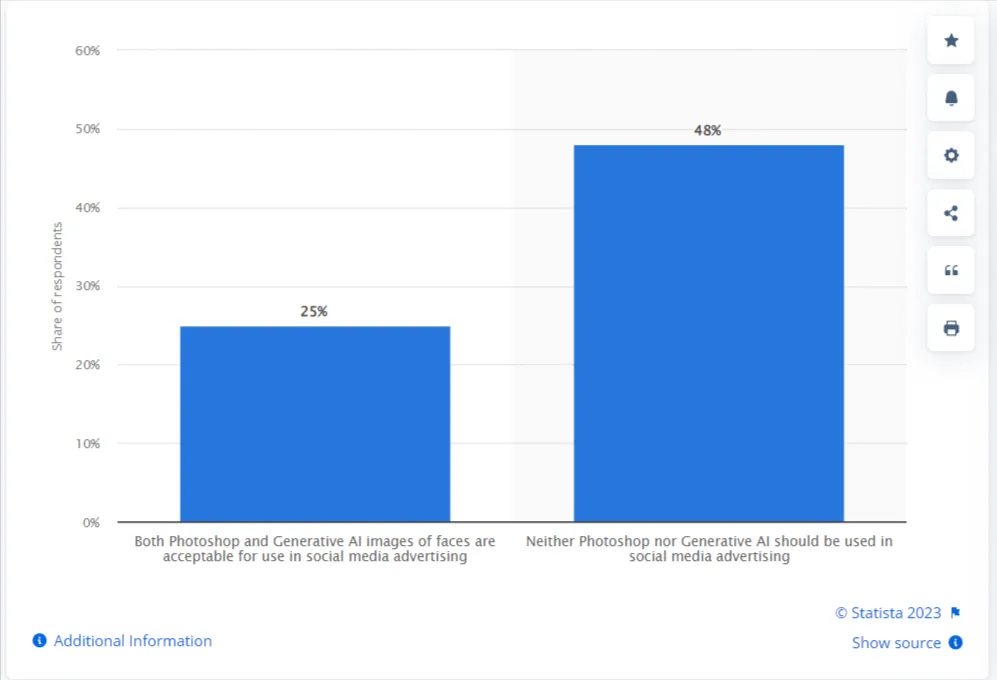
Trend #2: Merging Education With Entertainment
The Convergence of Education and Entertainment in Content Traversing the dynamic landscape of social media, the amalgamation of education and entertainment, often referred to as “infotainment,” emerges as a significant trend.
Contemporary audiences seek more than mere information; they crave a compelling and enjoyable experience. Infotainment has redefined how brands engage their audience, seamlessly blending the realms of learning and leisure to deliver content that leaves a lasting impression.
It’s no longer just about the message; it’s equally about the delivery. Brands are harnessing the power of storytelling, dynamic videos, and visually striking graphics to both inform and entertain.
What’s remarkable is that this approach transcends industry boundaries. Whether managing social media for non-profits, healthcare, or education, businesses now wield the ability to create content that not only imparts knowledge but also captivates and delights.

Trend #3: The Reign of Short-form Videos
The ascendancy of vertical short-form videos has become a defining trend across social media platforms like TikTok, Instagram, and YouTube’s “Shorts,” establishing them as a go-to strategy for brands.
Why Are Short-Form Videos So Impactful? Their succinct, mobile-friendly format aligns seamlessly with the demands of today’s fast-paced digital landscape, where grabbing audience attention swiftly is paramount.
- 73% of consumers prefer learning about a product or service through short-form videos.
- 59% of short-form videos are watched for 41-80% of their duration.
These brief videos offer brands a powerful tool to convey their message effectively, be it showcasing products, offering glimpses behind the scenes, or sharing quick tips. Their brevity not only suits the rapid pace of digital consumption but also enhances their ability to drive engagement.
Short-Form Video Trends and Brand Impact: Embracing short-form video trends enables brands to craft content that not only captures attention but also establishes an emotional connection with the audience. Through impactful storytelling, brands can leave a lasting impression, ensuring their message resonates long after the video concludes.
What’s Next? Tips to Leverage the Trend: If you haven’t incorporated short-form videos into your social media strategy yet, now is the time to start.
Choose Your Platforms Wisely: Align your choices with your target audience and brand voice.
Craft Compelling Content: Develop engaging, concise videos that tell compelling stories or showcase products effectively.
Stay Updated on Trends: Regularly explore the “For You,” “Reels,” and “Shorts” pages to remain informed about the latest short-form video trends and features.
Experiment and Stay Fresh: Try new formats, challenges, and interactive elements to keep your content dynamic and engaging.
Establish a Posting Schedule: Utilize a social media calendar to maintain a consistent posting schedule for your short-form videos.
Trend #4: The Blossoming Creator Economy
The Creator Economy Boom: Navigating Authentic Brand Engagement
According to a Goldman Sachs report, the creator economy is on track to nearly double in value, projected to reach $480 billion by 2027, up from its current valuation of $250 billion.
As the creator economy flourishes, it reshapes the dynamics of how people interact with brands on social media. Audiences, now more discerning, approach brand content with a healthy dose of skepticism, no longer fully trusting or engaging with everything posted on brand channels.
In this landscape, influencers and content creators emerge as pivotal players, celebrated for their authenticity and relatability. Their unique ability to connect with followers renders them invaluable for brand promotions.
What sets this social media trend apart?
Collaborating with creators allows businesses to cultivate trust and connection with their audience. It transcends mere product showcasing; it’s about demonstrating expertise and engaging in meaningful ways.
A compelling illustration is the collaboration between food influencer Kylie Perrotti and Homiah Foods. This partnership exemplifies how a brand can leverage a food blogger’s distinctive appeal and engaged audience to elevate its product visibility and desirability. In this evolving landscape, businesses find that connecting with creators isn’t just a marketing strategy; it’s a pathway to authentic engagement and brand resonance.
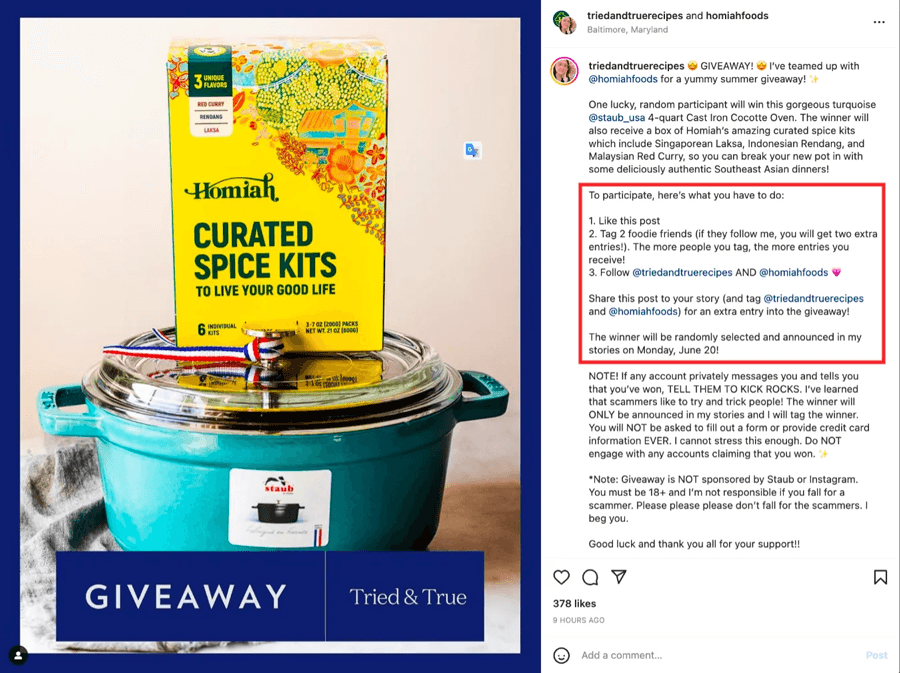
Leveraging Influencer Marketing: Strategies to Capitalize on the Trend
Homiah Foods’ collaboration with culinary influencer Kylie Perrotti showcases the transformative power of targeted influencer marketing. By aligning with Kylie’s culinary expertise and engaging content style, the brand successfully tapped into a new customer base.
What Can You Do Next to Harness This Trend?
Identify Micro-Influencers Thoughtfully: Seek out micro-influencers and content creators whose values align with your brand and resonate with your target audience. The authenticity of smaller influencers often brings a more genuine connection with their followers.
Collaborate Beyond Product Promotion: Move beyond traditional product promotion. Collaborate with influencers to showcase not just your products but also your brand’s expertise. Engage with the audience in meaningful ways, providing value beyond a sales pitch.
Align Content with Objectives: Ensure that the content created by influencers aligns with your brand objectives and seamlessly resonates with the interests of the audience. Authenticity in content is key to building trust.
Forge Long-Term Partnerships: Consider establishing long-term partnerships with influencers who can consistently represent your brand authentically. Building sustained relationships with influencers fosters credibility and enhances the effectiveness of your influencer marketing strategy.
Trend #5: Engagement is Moving to DMs
With social media feeds getting busy with the constant stream of sponsored and brand-specific content, engagement has moved to the closed corners of the platfrom.
Another reason for this shift is that people feel more at ease sharing their opinions within specific groups rather than putting them out there for everyone to see.
We’ve all seen how political and topical discussions in open spaces can turn into fiery arguments, causing more trouble than they’re worth.
On Instagram, more and more people are connecting with others through closed stories or DMs.
Adam Mosseri, the head of Instagram, also agreed that people on Instagram now post many more stories and send many more DMs than they post to their main feed.

Embracing Private Conversations: The Evolution of Social Media Engagement
Recognizing the growing preference for private conversations, Instagram has introduced several direct messaging (DM)-centered features, including Notes and Broadcast channels. In a similar vein, TikTok enables users to receive messages from anyone on the platform of their choosing.
This shift toward direct messaging not only caters to the audience’s love for more personal interactions but also solidifies social media’s role as a pivotal customer service channel.
The integration of chatbots, instant messaging, and AI-powered customer support has ushered in a transformative era in how consumers engage with brands. This evolution in communication channels not only facilitates seamless interaction but also underscores the importance of providing personalized and efficient customer service in the dynamic landscape of social media
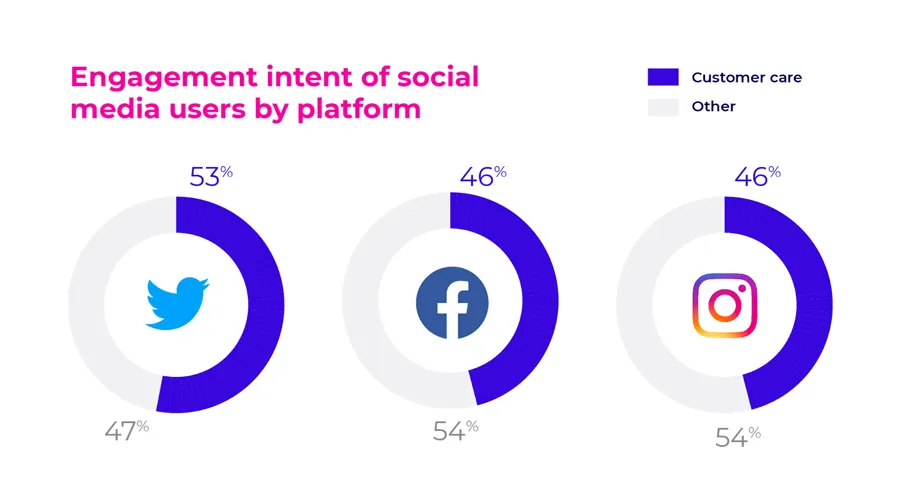
Seizing the Momentum: Strategies to Leverage Real-Time Social Media Engagement
The ability of businesses to offer real-time responses to customer inquiries and concerns has transformed these interactions into valuable opportunities for building trust, loyalty, and satisfaction. The chat window on social media now acts as an immediate bridge between brands and consumers, facilitating instant connection.
Key Actions to Harness This Trend:
Encourage Direct Communication: Foster direct communication by encouraging your audience to connect with questions and feedback through DMs. Creating an open channel for dialogue enhances the personal connection between your brand and customers.
Utilize Social Inbox Tools: Equip your social media team with social inbox tools like SocialPilot to efficiently manage and promptly respond to DMs across platforms. Streamlining communication channels enhances your team’s ability to provide real-time responses.
Implement Automated Responses: Set up automated responses to swiftly reply to frequently asked questions. This not only saves time but ensures that your audience receives immediate acknowledgment, contributing to a positive user experience.
Cultivate Community Relationships: Focus on transforming your social media following into a genuine community. Foster personal connections through DMs, groups, or channels. This approach cultivates more meaningful engagement and builds stronger relationships with your audience.
Collaborate with Influential Creators: Build relationships with influential creators who already have an established community on social channels. Partnering with these creators can extend your brand’s reach and tap into existing communities, enhancing your real-time engagement efforts.
Trend #6: Redefining Sustainability Communication
Embracing Sustainability: The Imperative for Modern Brands
Sustainability has evolved from a mere choice to an absolute necessity for contemporary brands. In an era where environmental consciousness takes precedence, brands adopting sustainable practices resonate profoundly with an expanding eco-conscious consumer base.
A staggering 84% of customers assert that they would distance themselves from a brand or company with poor environmental practices. This underscores the critical role of sustainability in shaping consumer perceptions and choices.
Social media emerges as a pivotal platform for these eco-friendly brands to share their sustainability initiatives, promote eco-conscious products, and highlight corporate responsibility efforts. However, a crucial caveat exists – authenticity and transparency in these communications are paramount.
Brands that effectively convey their sustainable practices and commitment to minimizing environmental impact create a robust connection with their audience. The alignment of brand values with those of eco-conscious consumers transcends a mere positive environmental impact; it becomes a foundation for building a loyal customer base.
An exemplary case in point is Patagonia, an American retailer of outdoor recreation clothing. Through its social media channels, Patagonia consistently showcases its unwavering commitment to environmental causes and sustainable practices. This transparent communication not only reinforces the brand’s values but also establishes a profound resonance with its audience.

To harness the sustainability trend:
Know Your Audience: Understand your audience’s eco-consciousness, preferences, and values.
Craft a Strategic Approach: Develop a focused social media strategy highlighting sustainability initiatives and eco-friendly products.
Share Authentic Stories: Communicate genuine stories about your sustainability journey and real-life impact reduction.
Encourage Participation: Drive engagement with eco-friendly challenges and discussions, fostering a sense of community.
Explore Partnerships: Consider collaborations with environmental organizations or influencers aligned with your sustainability values.
Trend #7: Social Media are Becoming Search Engines
Shifting Landscapes: Social Media as the New Information Hub
In a transformative shift, social media has become more than just a platform for connecting; it’s now a vital source for discovering news, products, and insights, challenging the dominance of traditional search engines.
According to Senior Vice President Prabhakar Raghavan of Google’s Knowledge & Information organization, nearly 40% of young people now turn to platforms like TikTok or Instagram instead of Google Maps or Search when seeking recommendations, like where to have lunch.
What’s driving this change? It boils down to convenience and relevance. Trust in recommendations and insights from real faces now outweighs faith in faceless websites, marking a significant evolution in how people seek and trust information.
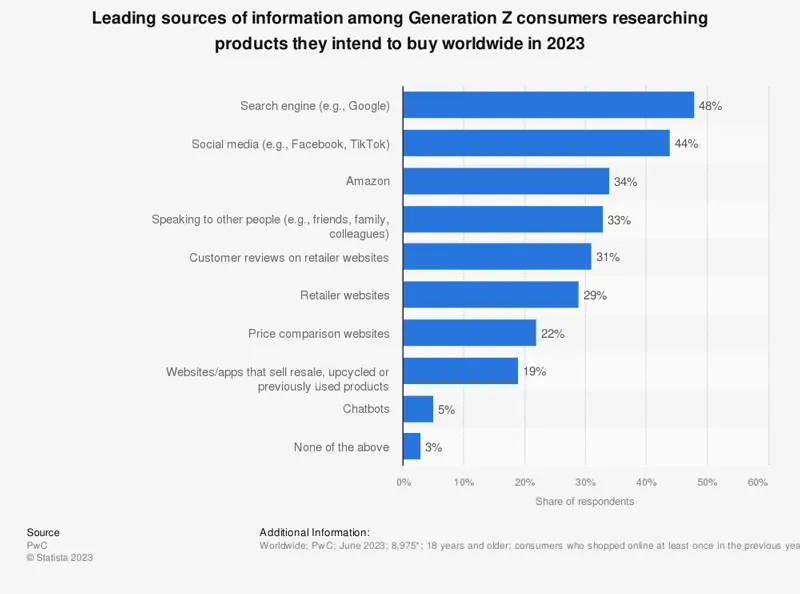
Evolution in Search Dynamics: Social Media Platforms Enhance Exploration
Meeting the audience’s exploration demands, social media platforms are enhancing their search experiences. TikTok, for example, now displays Google search results within its in-app results. Additionally, most social media platforms, TikTok included, have introduced functionalities allowing ads to be part of user search results.
However, it’s crucial not to abandon Google search efforts altogether. Despite the increasing reliance on social media for initial exploration, Gen Zers still turn to search engines to evaluate products or brands after their initial social media exploration. The synergy between social media exploration and subsequent detailed evaluations on search engines highlights the evolving role of both platforms in the consumer journey.
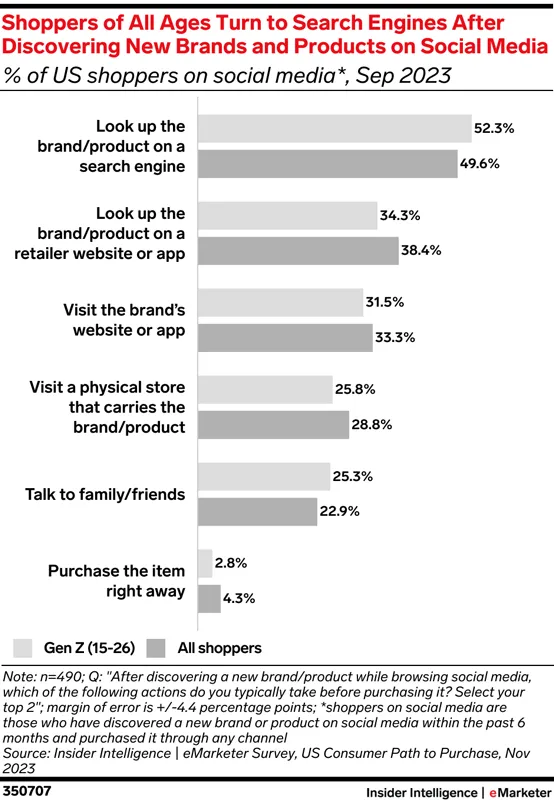
Trend #9: Championing Employee Advocacy
Leveraging Employee Advocacy: A Powerful Social Media Marketing Tool
Employee advocacy has emerged as a potent tool in the social media marketing arsenal, and here’s why:
Humanizing the Brand: When employees share their experiences and insights, they humanize the brand, establishing trust and authenticity in an era where genuine connections are highly valued.
Higher Engagement Rates: Employees’ personal networks often boast higher engagement rates than official brand channels, providing a unique avenue for reaching and resonating with a broader audience.
Authentic Perspectives: Employees can offer an authentic perspective by sharing aspects of company culture, achievements, and behind-the-scenes glimpses, fostering a deeper connection with consumers.
Cultural Integration: Employee advocacy goes beyond content sharing; it involves creating a culture where employees feel valued and connected to the brand’s mission. This sense of belonging leads to more passionate and effective advocacy, enhancing the brand’s reputation.
Strategies to Harness this Trend:
Identify Brand Ambassadors: Identify enthusiastic and engaged employees willing to become brand ambassadors.
Provide Training Sessions: Offer training sessions or resources to educate employees about effective social media practices and the guidelines they need to follow.
Facilitate Content Sharing: Make it easy for employees to share brand content by providing shareable assets like images, articles, videos, and relevant hashtags.
Recognition and Incentives: Offer shoutouts, incentives, or gamification to motivate and appreciate employees’ advocacy efforts.
Trend #11: Decentralized Platforms Will Gain More Traction
Embracing Decentralized Social Media: Strategies to Navigate the Trend
As decentralized social media platforms gain traction, consider these strategies to harness the trend:
Explore Decentralized Platforms: Create accounts and explore the functionality of decentralized platforms to gain firsthand experience and understanding of their operations.
Analyze Target Audience Presence: Assess whether your target audiences are already present on decentralized platforms or show interest in exploring them. Understanding audience preferences is key to effective engagement.
Stay Informed on Developments: Keep a close eye on developments in the decentralized space, including platform growth, emerging competitors, and regulatory changes. Being informed positions you to adapt your strategy accordingly.
Educate Stakeholders: Educate your stakeholders about the benefits and challenges of decentralized platforms. Help them make informed decisions about expanding their presence in this evolving space.
Trend #12: The Rise of Social Commerce
Revolutionizing E-Commerce: The Ascendancy of Social Commerce
The integration of online shopping and social media, known as social commerce, is reshaping the landscape of internet shopping. According to Statista, global social media sales are anticipated to reach $1.3 billion in 2023, with projections indicating a potential surge to nearly $3 trillion by 2026.
This convergence of social interaction and e-commerce is not just a trend but a paradigm shift, underscoring the significant impact of social commerce on the future of online retail.

Seizing the Social Commerce Wave: Strategies to Leverage the Growth
The significant growth in social commerce is fueled by the integration of in-app shopping experiences, transforming social media platforms into vibrant marketplaces. Platforms like TikTok, Instagram, and Facebook lead the way with features such as live shopping, shoppable videos, and product showcases.
To harness this trend effectively:
Choose the Right Platform: Assess which platform—TikTok, Facebook, or Instagram—best suits your brand. Focus on channels where their audience actively engages with product posts for more effective conversions.
Create Immersive Shopping Experiences: Focus on crafting engaging and immersive shopping experiences within the social media ecosystem. Incorporate elements like shoppable videos, live shopping events, and interactive content to captivate your audience.
Collaborate with Influencers: Collaborate with influencers who align with your brand and can effectively promote products within their niche communities. Influencers play a crucial role in driving awareness and engagement.
Adopt Shoppable Ads: Start incorporating Shoppable ads into your strategy to facilitate direct and streamlined purchasing experiences for your audience.